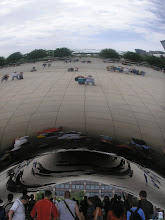In her journal response to Heitor Villa-Lobos’ Bachianas Brasileiras, Hannah makes certain the reader/listener understands the context in which the piece is a masterpiece. Likening it to a pasta salad, and prompting me to reach for a late-night snack, she tells us that the magic of the piece lies not in the individual ingredients, but in the “synthesis of those individual components.” From looking at the two-faced title of the piece, to the titles of the movements, which take one name from Baroque terminology and another from Brazilian folk terminology, to the makeup of the music itself, which draws on Bachian forms and Brazilian sonorities, it is easy to divide the piece into Baroque noodles and Brazilian salad dressing, rather than seeing it as a delicious pasta salad, as Hannah describes it.
Nevertheless, it is nearly impossible to listen to the piece without picking the elements of the music apart and assigning them to either of Villa-Lobos’ foundations for the piece, as Hannah goes on to do in her reactions to the movements. Similar to what Hannah describes, I had difficulty hearing Bachian influences in the first two movements of No. 1. Aside from being in ABA form, I could not look past the singing melodies, pulsating syncopations, and modal sonorities that placed them clearly in the “Brazilian salad dressing” category. This is especially true of the rhythmic complexity of the first movement and the beautiful songlike melodies of the second- which Hannah aptly described as giving the “impression of evening serenades, balcony scenes, and street bands.” Parts of the latter movement certainly sounded to me like they could be underscoring a hopelessly cheesy love scene in an old movie- an emotion I wouldn’t often think of while listening to Bach. The third movement, however finally gives the feeling of Baroque melody and imitative forms, while retaining the syncopations of Brazilian rhythms.
No. 6 is sonically very different, in that the two voices, flute and bassoon, are much farther apart, as opposed to the similar voices of the cellos in No. 1. The first movement moves between sections that sound very much Brazilian in melody and very much Baroque in counterpoint. In the second movement, the movement of the bass, as heard in the bassoon, part is clearly Baroque and evokes the sounds of Bachian walking bass. Meanwhile, the flute is given virtuosic melody in constant motion.
While not always equal in representation in each movement, Villa-Lobos’ successfully melds Bach’s Baroque styles with those of his own native Brazilian folk music. However, I would like to hear more from Hannah as to why this dichotomy needed to exist in the first place. When Villa-Lobos composed these pieces between 1930 and 1945 he was actually taking part in a revolution. Getulio Vargas overtook the Old Republic regime in Brazil and sought to unite his people under his own authoritarian rule. Of course, as in similar situations around the world, a fledgling government in a fledgling country looked to music as a way to establish an individual identity in the world. Heitor Villa-Lobos was handed control of the music education system in the country, and became the musical emblem of Brazil through his compositions. But it seems strange that he would use European elements to create a nationalistic style. Why not create a style uniquely Brazilian, as did Ives in the United States? Shouldn’t he have taken his music away from reliance on Europe? In Hannah’s response, she mentions that Villa-Lobos saw Bach as a “universal folkloric source” however, when asked “what is folklore?” Villa-Lobos is known to have exclaimed “I am folklore!” This is, in essence, the conflict I see in this piece. Although Villa-Lobos is trying to create something entirely his own, he is still reliant on his idol, Bach.
Despite the problems I see in this piece from a political perspective, I do still agree with Hannah in that it should be included in the canon. Even if it doesn’t create something wholly Brazilian, it is a masterpiece in the realm of neoclassicism of the twentieth century.
Subscribe to:
Post Comments (Atom)


No comments:
Post a Comment